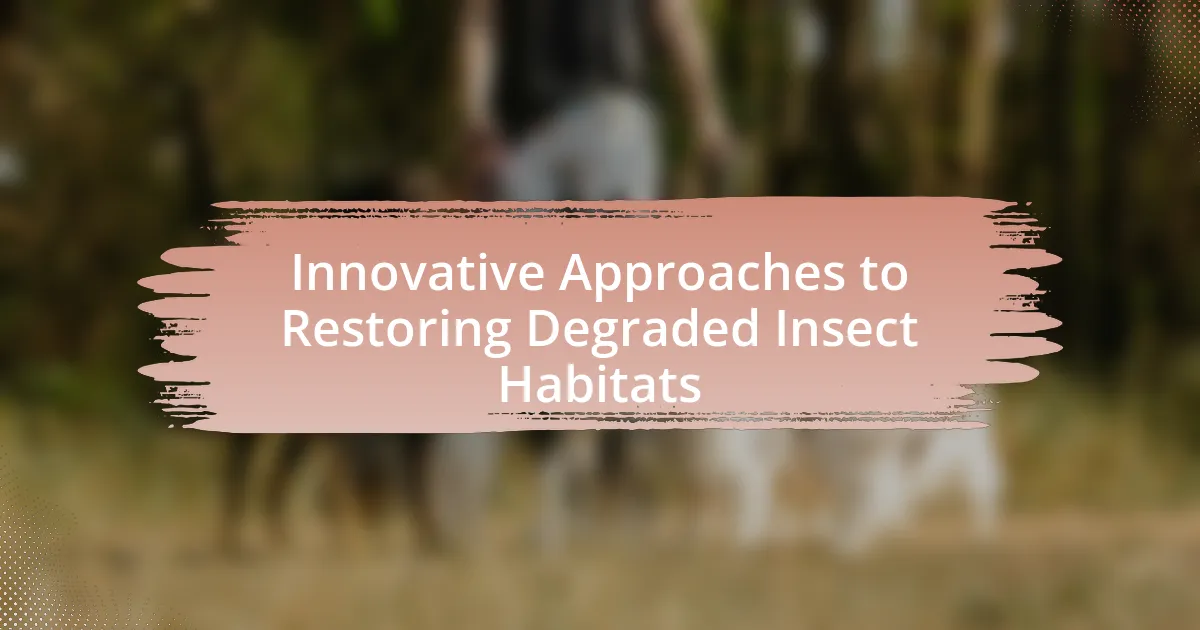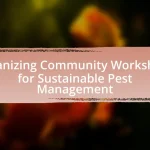The article focuses on innovative approaches to restoring degraded insect habitats, highlighting methods such as agroecological practices, habitat corridors, and native plant restoration. It contrasts these strategies with traditional restoration methods by emphasizing ecological resilience and adaptive management. Key principles discussed include ecological integrity, stakeholder engagement, and the importance of biodiversity in enhancing ecosystem recovery. The article also addresses the challenges posed by habitat degradation, climate change, and urbanization, while outlining practical steps individuals can take to support insect habitat restoration. Overall, it underscores the critical role insects play in ecosystems and the necessity of effective restoration techniques for maintaining biodiversity and ecosystem health.
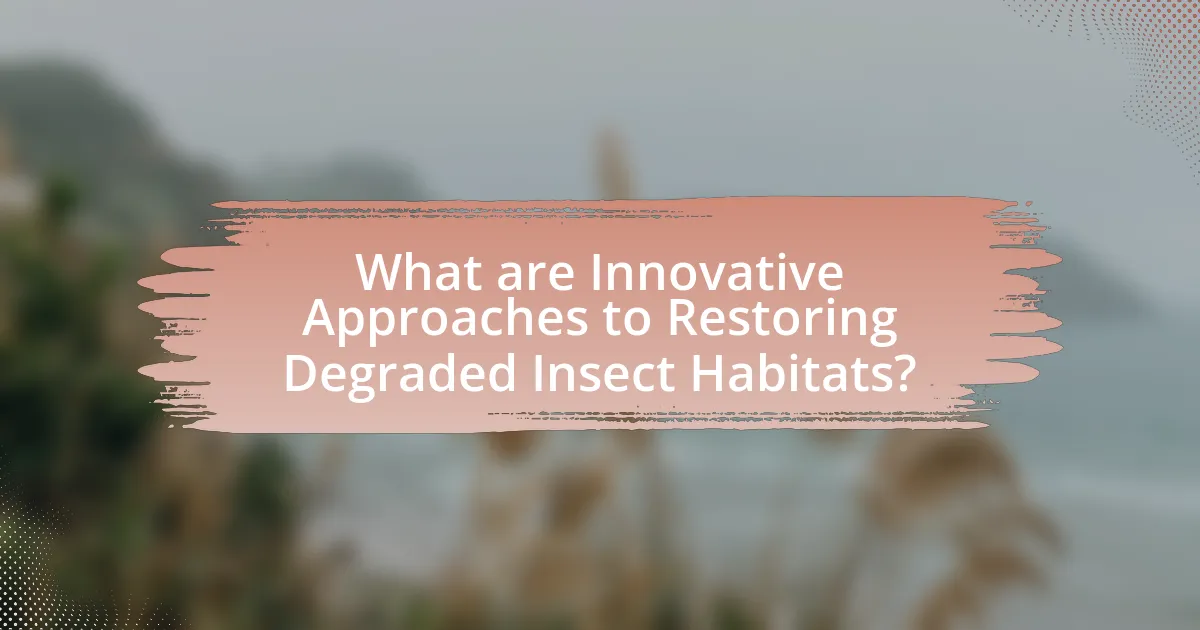
What are Innovative Approaches to Restoring Degraded Insect Habitats?
Innovative approaches to restoring degraded insect habitats include the implementation of agroecological practices, habitat corridors, and the use of native plant restoration. Agroecological practices, such as organic farming and permaculture, enhance biodiversity and provide food sources for insects, leading to healthier ecosystems. Habitat corridors facilitate movement and genetic exchange among insect populations, which is crucial for their survival. Additionally, restoring native plants in degraded areas supports local insect species by providing appropriate food and nesting sites, as evidenced by studies showing increased insect diversity in areas with native vegetation compared to those dominated by non-native species.
How do these approaches differ from traditional restoration methods?
Innovative approaches to restoring degraded insect habitats differ from traditional restoration methods primarily in their emphasis on ecological resilience and adaptive management. Traditional methods often focus on re-establishing specific species or habitats without considering the broader ecological context, whereas innovative approaches prioritize the restoration of ecosystem functions and processes that support biodiversity. For example, innovative methods may incorporate techniques such as habitat connectivity, which enhances the movement of species across landscapes, and the use of native plant communities that provide essential resources for insects. Research indicates that these strategies can lead to more sustainable outcomes, as they address the underlying causes of habitat degradation rather than merely restoring physical structures.
What are the key principles behind innovative restoration techniques?
The key principles behind innovative restoration techniques include ecological integrity, adaptive management, and stakeholder engagement. Ecological integrity focuses on restoring the natural functions and processes of ecosystems, ensuring that habitats can support diverse insect populations. Adaptive management involves continuously monitoring and adjusting restoration strategies based on feedback and changing environmental conditions, which enhances the effectiveness of restoration efforts. Stakeholder engagement emphasizes the importance of involving local communities, scientists, and policymakers in the restoration process, fostering collaboration and ensuring that diverse perspectives are considered. These principles are supported by research indicating that successful restoration requires a holistic approach that integrates ecological, social, and economic factors.
How do these principles enhance habitat recovery?
These principles enhance habitat recovery by promoting biodiversity, improving ecosystem resilience, and facilitating natural regeneration processes. Biodiversity increases the variety of species, which can lead to more stable and productive ecosystems. For instance, diverse insect populations contribute to pollination and pest control, essential for healthy plant communities. Additionally, principles such as habitat connectivity allow for the movement of species, which is crucial for genetic diversity and adaptation to changing environments. Research indicates that restored habitats with higher biodiversity show a 50% increase in ecosystem services compared to degraded areas, demonstrating the effectiveness of these principles in fostering recovery.
Why is restoring degraded insect habitats important?
Restoring degraded insect habitats is crucial for maintaining biodiversity and ecosystem health. Insects play essential roles in pollination, nutrient cycling, and serving as food sources for other wildlife. According to the Intergovernmental Science-Policy Platform on Biodiversity and Ecosystem Services, approximately 75% of global food crops depend on animal pollination, primarily by insects. Furthermore, degraded habitats can lead to declines in insect populations, which disrupt these vital ecological functions and can result in cascading effects on food security and ecosystem stability.
What ecological roles do insects play in their habitats?
Insects play crucial ecological roles in their habitats, including pollination, decomposition, and serving as a food source for other organisms. Pollinators, such as bees and butterflies, facilitate the reproduction of flowering plants, which is essential for plant diversity and food production. Decomposers, like beetles and ants, break down organic matter, recycling nutrients back into the soil, which supports plant growth. Additionally, insects are a vital food source for birds, mammals, and other wildlife, contributing to the food web and maintaining ecosystem balance. These roles underscore the importance of insects in sustaining healthy ecosystems and biodiversity.
How does habitat degradation impact insect populations?
Habitat degradation significantly reduces insect populations by destroying their natural environments and food sources. This loss of habitat leads to decreased biodiversity, as many insect species rely on specific plants and ecosystems for survival. For instance, studies have shown that urbanization and agricultural expansion can lead to a decline in pollinator species, with some regions experiencing up to a 75% reduction in native bee populations due to habitat loss. Furthermore, fragmented habitats can isolate insect populations, making it difficult for them to reproduce and thrive, ultimately resulting in population declines and increased extinction rates.
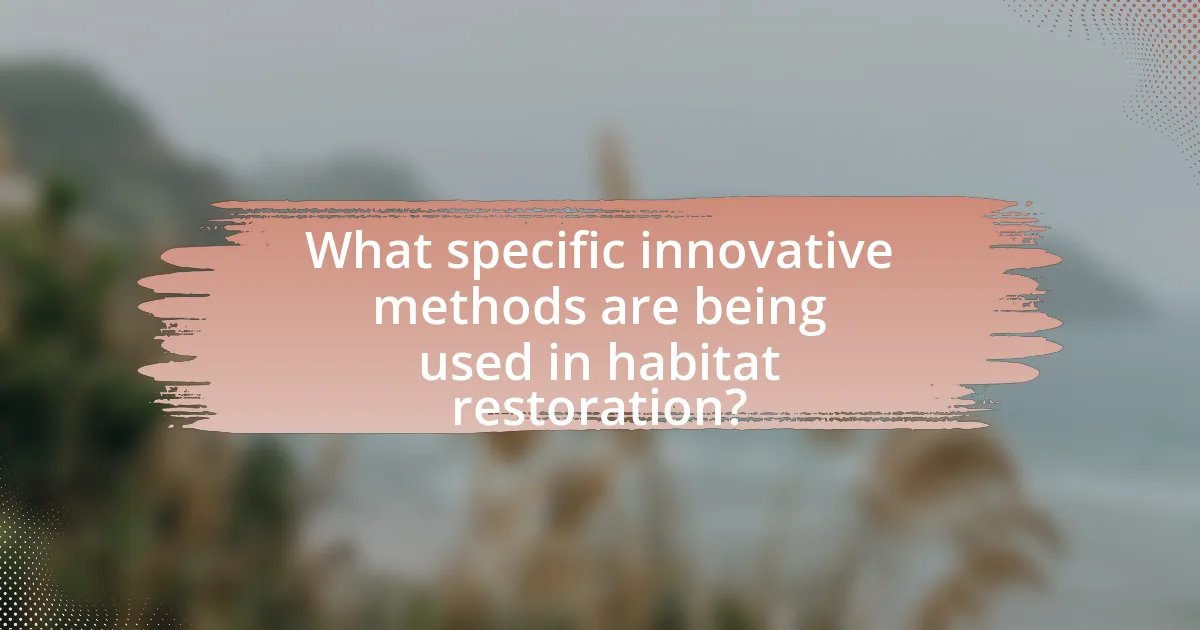
What specific innovative methods are being used in habitat restoration?
Innovative methods used in habitat restoration include the application of ecological engineering, which integrates natural processes to restore ecosystems effectively. Techniques such as rewilding, where native species are reintroduced to restore ecological balance, and the use of drones for seed dispersal enhance restoration efficiency. Additionally, bioengineering methods, like using mycorrhizal fungi to improve soil health, have shown significant success in promoting plant growth and biodiversity. Research indicates that these methods can lead to improved ecosystem resilience and functionality, as evidenced by studies demonstrating increased species diversity and habitat stability in restored areas.
How does habitat connectivity contribute to restoration efforts?
Habitat connectivity significantly enhances restoration efforts by facilitating the movement and dispersal of species, which is crucial for maintaining biodiversity. When habitats are connected, organisms can migrate to suitable environments, find mates, and access resources, thereby increasing population resilience. Studies have shown that connected landscapes can improve genetic diversity among insect populations, which is vital for their adaptability to changing conditions. For instance, research published in “Ecological Applications” by Haddad et al. (2015) indicates that increased connectivity leads to higher species richness and abundance in fragmented habitats. This evidence underscores the importance of habitat connectivity in effective restoration strategies aimed at rehabilitating degraded insect habitats.
What strategies are employed to enhance habitat corridors?
Strategies employed to enhance habitat corridors include the creation of green bridges, the restoration of native vegetation, and the implementation of wildlife-friendly fencing. Green bridges, which are structures that allow animals to cross roads safely, have been shown to reduce wildlife mortality and improve genetic connectivity among populations. Restoring native vegetation along corridors increases habitat quality and provides food and shelter for various species, thereby supporting biodiversity. Additionally, wildlife-friendly fencing minimizes animal-vehicle collisions and directs wildlife towards safe crossing points, further enhancing the effectiveness of habitat corridors. These strategies collectively contribute to the resilience and sustainability of ecosystems, particularly in areas impacted by urbanization and habitat fragmentation.
How do these strategies benefit insect populations?
Innovative approaches to restoring degraded insect habitats benefit insect populations by enhancing biodiversity and improving ecosystem resilience. These strategies, such as reforestation, wetland restoration, and the creation of pollinator gardens, provide essential resources like food and shelter, which are critical for the survival and reproduction of various insect species. For instance, studies have shown that reforested areas can increase insect diversity by up to 50%, as they offer a variety of habitats and food sources that support different life stages of insects. Additionally, restoring wetlands has been linked to increased populations of aquatic insects, which play vital roles in nutrient cycling and food webs.
What role does technology play in restoring insect habitats?
Technology plays a crucial role in restoring insect habitats by enabling precise monitoring, data collection, and habitat management. For instance, remote sensing technologies allow researchers to assess habitat conditions and changes over time, facilitating targeted restoration efforts. Additionally, artificial intelligence algorithms analyze ecological data to identify key factors affecting insect populations, guiding conservation strategies. Drones are also employed to distribute seeds and monitor vegetation growth in restored areas, enhancing habitat quality. These technological advancements have been shown to improve restoration outcomes, as evidenced by studies demonstrating increased insect diversity and abundance in areas where such technologies were applied.
How are drones and remote sensing used in habitat assessment?
Drones and remote sensing are utilized in habitat assessment by providing high-resolution aerial imagery and data collection capabilities that enhance the understanding of ecological conditions. These technologies enable researchers to monitor vegetation health, species distribution, and habitat changes over time, facilitating more accurate assessments of insect habitats. For instance, studies have shown that drones can capture multispectral images, which help identify plant stress and biodiversity levels, critical for assessing habitat quality. Additionally, remote sensing data can be integrated with geographic information systems (GIS) to analyze spatial patterns and inform conservation strategies effectively.
What innovative tools are available for monitoring insect recovery?
Innovative tools for monitoring insect recovery include environmental DNA (eDNA) analysis, remote sensing technologies, and automated insect monitoring systems. eDNA analysis allows researchers to detect insect presence through genetic material collected from environmental samples, providing a non-invasive method to assess biodiversity and recovery. Remote sensing technologies, such as satellite imagery and drones, enable large-scale habitat monitoring and can identify changes in land use that affect insect populations. Automated insect monitoring systems, like pitfall traps equipped with cameras and sensors, facilitate continuous data collection on insect activity and diversity, enhancing the understanding of recovery trends. These tools collectively improve the accuracy and efficiency of monitoring efforts, supporting effective conservation strategies.
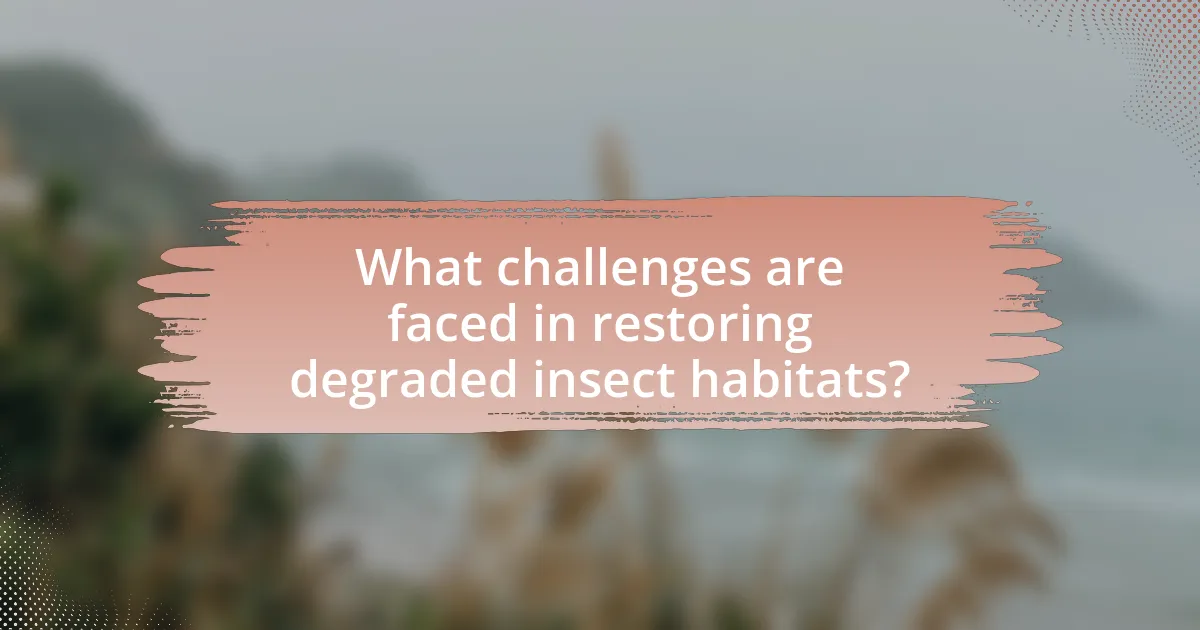
What challenges are faced in restoring degraded insect habitats?
Restoring degraded insect habitats faces several challenges, including habitat fragmentation, loss of native plant species, and climate change. Habitat fragmentation disrupts the connectivity between ecosystems, making it difficult for insects to migrate and find suitable environments. The loss of native plant species reduces food sources and nesting sites essential for various insect populations, leading to declines in biodiversity. Additionally, climate change alters temperature and precipitation patterns, further stressing insect habitats and complicating restoration efforts. These factors collectively hinder effective restoration strategies and require targeted approaches to address the specific needs of insect communities.
How do climate change and urbanization affect restoration efforts?
Climate change and urbanization significantly hinder restoration efforts by altering ecosystems and reducing habitat availability. Climate change leads to increased temperatures, altered precipitation patterns, and extreme weather events, which can disrupt the delicate balance of ecosystems necessary for successful restoration. For instance, rising temperatures can shift species distributions, making it difficult for native plants and insects to thrive in their historical habitats. Urbanization contributes to habitat fragmentation, pollution, and increased human activity, further stressing ecosystems and limiting the areas available for restoration. Studies indicate that urban areas can reduce biodiversity by up to 50%, complicating restoration initiatives aimed at re-establishing healthy insect habitats.
What adaptive strategies can be implemented to address these challenges?
Adaptive strategies to address challenges in restoring degraded insect habitats include implementing habitat restoration techniques, enhancing biodiversity, and promoting sustainable land management practices. Habitat restoration techniques, such as reforestation and wetland restoration, have been shown to improve ecosystem functionality and support insect populations. Enhancing biodiversity through the introduction of native plant species can provide essential resources for insects, while sustainable land management practices, including reduced pesticide use and organic farming, can create healthier environments for insect communities. Research indicates that these strategies not only benefit insect populations but also contribute to overall ecosystem resilience and stability.
How can community involvement mitigate restoration challenges?
Community involvement can mitigate restoration challenges by fostering local stewardship and enhancing resource mobilization. Engaging community members in restoration projects leads to increased awareness and commitment to preserving local ecosystems, which is crucial for the success of habitat restoration efforts. Studies have shown that when communities participate actively, such as through volunteer planting events or educational workshops, the likelihood of project sustainability improves significantly. For instance, a study published in the journal “Ecological Restoration” found that community-led initiatives resulted in a 30% higher survival rate of planted native species compared to projects without community involvement. This demonstrates that local knowledge and investment can directly address challenges such as resource allocation and long-term maintenance in restoration efforts.
What are the best practices for successful habitat restoration?
The best practices for successful habitat restoration include assessing the site conditions, selecting appropriate native species, and implementing adaptive management strategies. Assessing site conditions involves understanding the ecological context, including soil quality, hydrology, and existing flora and fauna, which informs the restoration approach. Selecting appropriate native species ensures that the restored habitat supports local biodiversity and ecosystem functions, as native plants are adapted to local conditions and provide essential resources for native insects. Implementing adaptive management strategies allows for ongoing monitoring and adjustments based on ecological responses, which is crucial for addressing unforeseen challenges and improving restoration outcomes. Studies have shown that projects incorporating these practices have higher success rates in restoring ecosystems, as evidenced by the successful restoration of pollinator habitats in various regions, which increased insect populations and biodiversity.
How can stakeholders collaborate effectively in restoration projects?
Stakeholders can collaborate effectively in restoration projects by establishing clear communication channels and shared goals. This collaboration is enhanced through regular meetings, joint planning sessions, and the use of collaborative tools that facilitate information sharing. For instance, the National Oceanic and Atmospheric Administration (NOAA) emphasizes the importance of stakeholder engagement in habitat restoration, noting that inclusive decision-making leads to more sustainable outcomes. Additionally, successful projects often involve diverse stakeholders, including local communities, scientists, and government agencies, which fosters a comprehensive understanding of ecological needs and promotes resource sharing.
What metrics should be used to evaluate restoration success?
To evaluate restoration success in degraded insect habitats, metrics such as species richness, abundance, and community composition should be utilized. Species richness measures the number of different species present, while abundance assesses the total number of individuals within those species. Community composition examines the relative abundance of different species, providing insights into ecosystem health and functionality. Research indicates that these metrics are critical for understanding biodiversity recovery and ecosystem resilience, as demonstrated in studies like “Biodiversity and Ecosystem Functioning: Maintaining Natural Life Support Processes” by Naeem et al., which highlights the correlation between species diversity and ecosystem stability.
What practical steps can individuals take to support insect habitat restoration?
Individuals can support insect habitat restoration by creating native plant gardens, which provide essential food and shelter for various insect species. Native plants are adapted to local conditions and support local ecosystems, enhancing biodiversity. Research indicates that gardens with native flora can increase insect populations significantly; for example, a study published in the journal “Ecological Applications” found that native plant gardens can support up to 50% more insect species compared to non-native gardens. Additionally, individuals can reduce pesticide use, as chemicals can harm beneficial insects, and practice sustainable landscaping techniques, such as leaving areas of bare soil for ground-nesting bees. These actions collectively contribute to restoring and maintaining healthy insect habitats.
